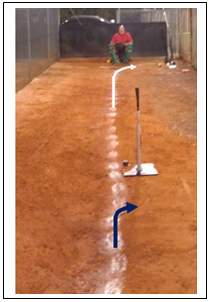|
A Simple Way to Increase Your Pitch Movement NOTE: Click here to download a quick Essential Pitch Keys & Movement Chart Pitching is the one skill we can complicate in a second. In fact, people who admittedly don’t know much about pitching will continue talking about all the complicated things they’ve heard others say about it. Perpetuating pitching rumors is common, as is the bizarre need to complicate things. Pitching isn’t difficult because it’s so complicated. It’s difficult because the pitcher is held to an unrealistic standard of excellence. If your shortstop makes 3 errors in a game chances are she’s still your shortstop. But, if your pitcher makes 3 bad pitches at the wrong time to the wrong batter, you don’t hesitate to pull her. The mechanics of pitching are pretty similar to those of throwing overhand, or even hitting. But we tend to only teach what the student needs with both throwing and hitting, while we just can’t seem to stop ourselves from pouring on more information when it comes to pitching. More isn’t always better, especially when it comes to performing a skill. Players do skills with their bodies based on what their minds understand. Too much information creates mental confusion, which leads to a physical wreck. Instead of complicating things with too much instruction, I suggest you go in the opposite direction – and simplify. Help your players organize all the information that’s currently in their brain by picking out the 2-3 most important things necessary for them to execute the skill, and then helping them place those 2-3 things in order of importance. A pitcher isn’t trying to do everything right, she’s only trying to do the 2-3 key things necessary for her to successfully execute this pitch. Helping your players simplify the information in their heads is a great first step toward helping them calm down mentally, stay calm during big game moments, and being successful at whatever they’re trying to do. When it comes to pitchers throwing their different pitches, they can get really complicated and distracted – which is why so many of their pitches don’t break the way they should. If you ask any of your pitchers what they must do in order to make a pitch break – every single one of them is going to answer “spin”. And while that’s not necessarily wrong, it isn’t right enough. The reason I say that is because crappy pitches spin. Simply getting a ball to spin is too vague. Fastballs spin and yet they don’t break like curveballs, or riseballs, or dropballs or screwballs – and yet they spin. So “spin” by itself isn’t enough to make pitches really move. So, what is required to make a pitch break? It’s simple. Balls move in the direction they spin, as fast as they spin. Fastballs spin down and so do dropballs, but dropballs spin down faster than fastballs. Both pitches “spin” in the same direction, but they don’t spin at the same speed. Make sense? So in order for pitchers to make their pitches actually move, or break, they need to:
All of this twisting, or spinning, is done with the pitcher’s hand and not her feet! Too many pitchers try and throw all the different pitches using their feet and their bodies. A pitcher’s stride can act as a helper to her hand, but it can never replace what her hand is doing to the ball!! That’s key! The only body part that a pitcher will ever use to touch the ball is her Hand, and because of that, her Hand is always the most important thing she’s trying to move. Pitchers give different names to their different pitches and while this sounds very cool, it actually serves to confuse pitchers as it makes them think that each of their different pitches is a completely different motion with zero connection to any of the other ones. And nothing is farther from the truth. Remember that pitches move in the direction they spin and as fast as they spin, so a pitcher wants to concentrate on the part of her motion – her release point – when she creates the spin speed and direction. So with that in mind, let’s look at a simple way to help pitchers better understand what their hand needs to do to throw all the different pitches. Have your pitchers think of every pitch as either a twist left, twist right, twist up, twist down or push forward. That already makes things sound a lot simpler! So, if your pitcher is right handed, I just described a Curveball (twist left), Screwball (twist right), Riseball (twist up), Dropball (twist down) and Fastball (push forward). An easy way to help your pitchers really focus on what their hands need to do at the release point in order to make the ball move correctly near the batter is to use a simple container of baby powder. Go to any dollar store and get a huge container of baby powder. Then sprinkle the baby powder on the ground in the exact path of the pitch your pitcher is practicing. In the picture on the right, the white line (baby powder) shows a Screwball for a right handed pitcher. Just having this visual on the field really helps pitchers tell if they’re breaking the ball too early, too late, or not at all. Then, take your baby powder and make the same pattern that you used for the pitch path to show the pitcher the path her hand must take at her release point (the blue line in the picture). Both paths will be the same – which really helps pitchers understand that what they do with their hand at the release point is what they see the ball do down by the batter. Note that while this works great for curveballs and screwballs, you can’t use it for dropballs and riseballs since you can’t show up and down with a chalk line. Use any method and opportunity you can to simplify pitching. Make the path of their pitches visual by using baby powder, start close and go slow before moving back and going fast – and watch how much your pitchers will improve. For more help with you pitchers, check out Softball Excellence! And don’t forget to download your free Essential Pitch Keys & Movement Chart |
|
|



 Pitcher’s commonly think that their grip, their stride and their follow through are the things they need to do to make their pitches move. And while all of these things are certainly helpers, they are not primary pitch movers. Did you notice how none of these things deal with the release of the ball? The release of the ball is when the pitcher actually makes the ball spin in the right direction – or not. The pitcher’s release is THE MOST important part of her motion since it’s when she lets go of the ball. Nail the release and you’ll nail the pitch. Likewise, if you botch the release, you’ll botch the pitch.
Pitcher’s commonly think that their grip, their stride and their follow through are the things they need to do to make their pitches move. And while all of these things are certainly helpers, they are not primary pitch movers. Did you notice how none of these things deal with the release of the ball? The release of the ball is when the pitcher actually makes the ball spin in the right direction – or not. The pitcher’s release is THE MOST important part of her motion since it’s when she lets go of the ball. Nail the release and you’ll nail the pitch. Likewise, if you botch the release, you’ll botch the pitch.


